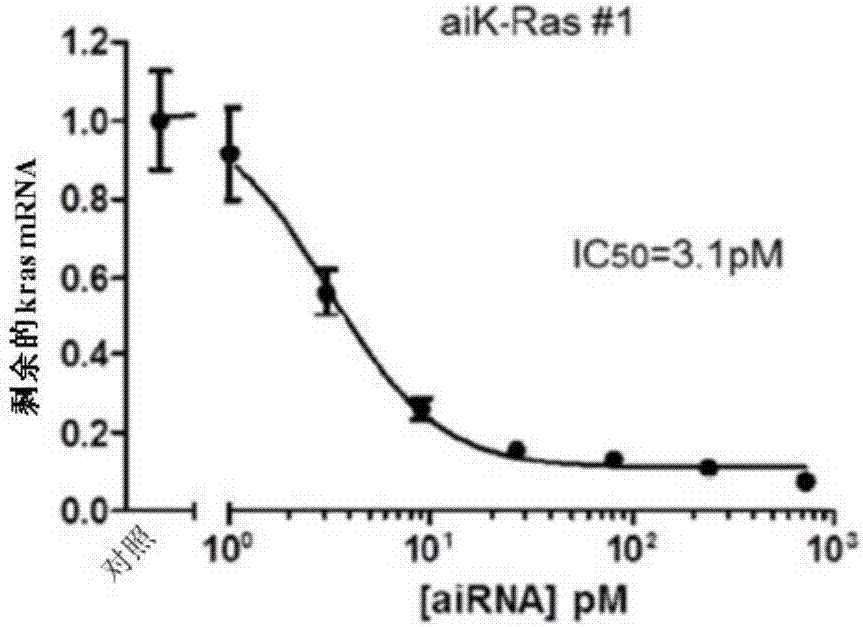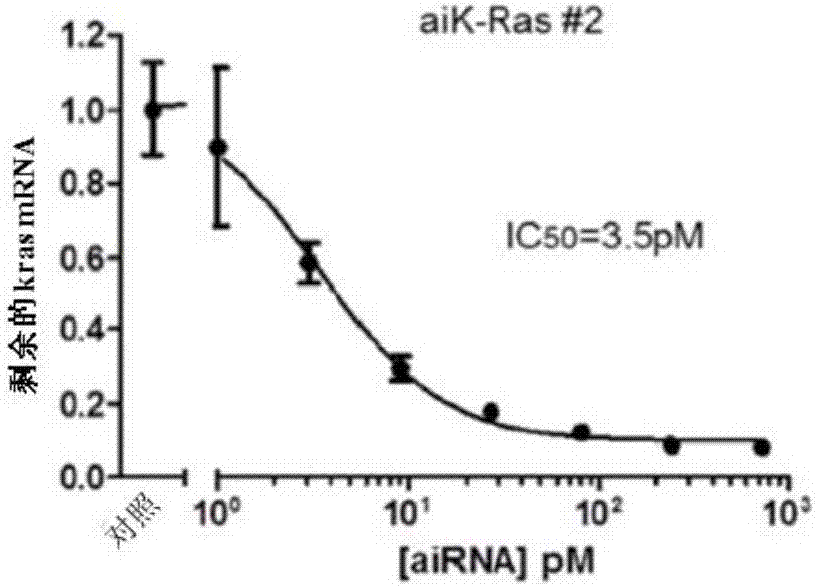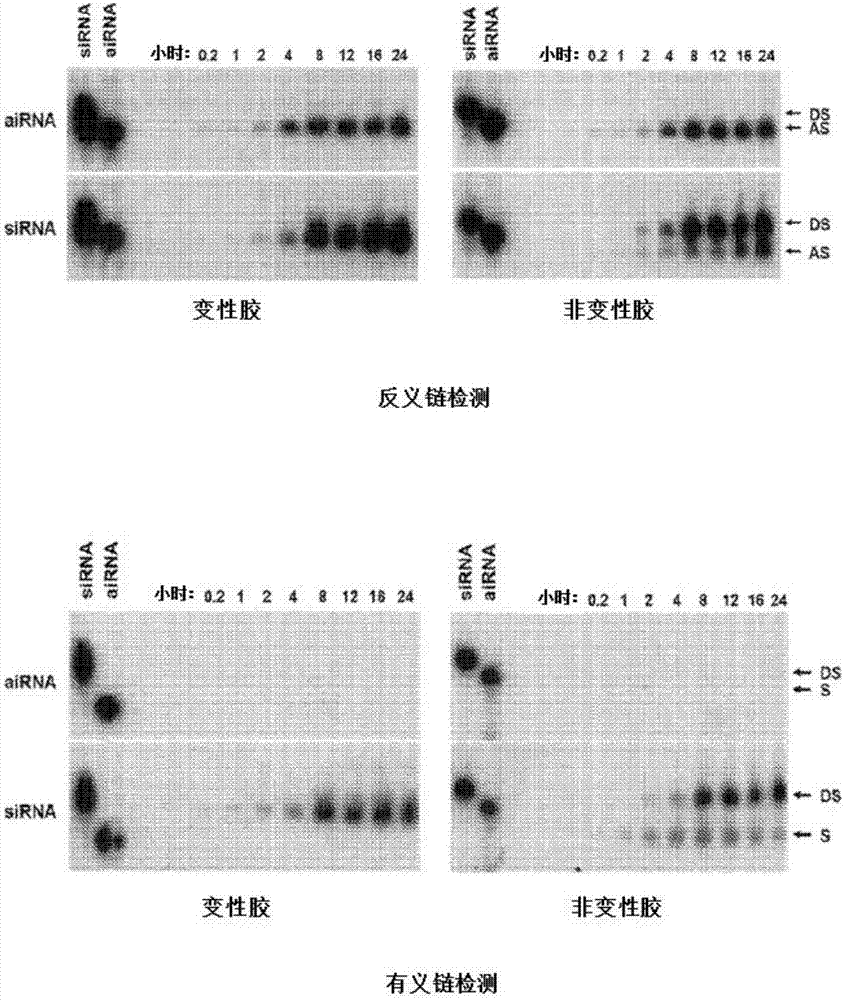Asymmetric interfering RNA compositions that silence K-RAS and methods of uses thereof
A technology of gene silencing and nucleotides, applied in the field of compositions for silencing K-Ras gene expression, can solve problems such as the unknown role of oncogenes
- Summary
- Abstract
- Description
- Claims
- Application Information
AI Technical Summary
Problems solved by technology
Method used
Image
Examples
Embodiment 1
[0139] Example 1: In vitro potency of aiK-Ras
[0140] Figure 1(A) shows in vitro studies using aiRNA ID NO: 21 ("aiK-Ras#1") targeting the K-Ras target SEQ ID NO: 22 to determine the IC of aiK-Ras#1 50 . DLD1 cells (ATCC) were transfected with aiK-Ras#1. Forty-eight hours after transfection, cells were collected and RNA was isolated. Determination of the IC of aiK-Ras#1 by qPCR 50 . The remaining mRNAs were normalized to GAPDH expression levels. IC 50 It is 3.1pM, indicating that aiK-Ras#1 efficiently silences K-Ras gene expression.
[0141] Figure 1(B) shows an in vitro study using aiRNA ID NO: 142 ("aiK-Ras#2") targeting the K-Ras target SEQ ID NO: 142 to determine the IC of aiK-Ras#2 50 . DLD1 cells were transfected with aiK-Ras#2. Forty-eight hours after transfection, cells were collected and RNA was isolated. Determination of the IC of aiK-Ras#2 by qPCR 50 . The remaining mRNAs were normalized to GAPDH expression levels. IC 50 It is 3.5pM, indicating ...
Embodiment 2
[0142] Example 2: Off-target effects of aiK-Ras reduction
[0143] Figure 2(A) shows detection of siRNA and aiRNA loaded in RISC by northern blot analysis. To analyze small RNA RISC loading, HEK293Flag-Ago2 stable cell lines were transfected with aiRNA or siRNA duplexes. Cells were lysed at indicated time points and co-immunoprecipitated with Flag antibody (Sigma, Catalog #F1804). The immunoprecipitate was washed, RNA was extracted from the complex with TRIZOL (Life Technologies, 15596-018), and loaded onto 15% TBE-Urea PAGE or 15% TBE non-denaturing PAGE gel. After electrophoresis, transfer RNA to Hybonad-XL Nylon membrane. The r-P32-labeled probe for detecting the sense or antisense strand is then hybridized to the RNA on the membrane. HEK293 cells expressing Flag-Ago2 (Invivogen, Catalog#293-null) were transfected with siRNA or aiRNA, and then co-immunoprecipitation assay was performed. FLAG-Ago2 HEK293 cells stably expressing FLAG-Ago2 were formed by transient transf...
Embodiment 3
[0146] Example 3: aiK-Ras sensitivity in K-Ras mutant cells
[0147] Fig. 3(A) shows the colony formation assay of AGS (ATCC) and DLD1 transfected with aiK-Ras#1 or aiK-Ras#2. Cells were transfected with 1 nM GFP aiRNA (control; GGTTATGTACAGGAACGCA (SEQ ID NO: 956)) or 1 nM aiK-Ras#1 or aiK-Ras#2 for 24 hours. Cells were then trypsinized and transferred to 6-well plates at 500-2000 cells / well to test the clonogenicity of the cells. After 11-14 days, colonies were stained with Giemsa stain and counted. For western blot analysis, the cells were washed with ice-cold PBS, in lysis buffer [50mM Hepes (pH 7.5), 1% Nonidet P-40, 150mM NaCl, 1mM EDTA, 1X Halt Proteasome Inhibitor Cocktail (Thermo Scientific, Catalog #87786)]. Solubilized proteins (10 μg) were separated by SDS / PAGE and transferred to PVDF membranes. Primary antibodies were used in this assay. Antigen-antibody complexes were visualized by enhanced chemiluminescence (BioRad, Catalog #170-5060).
[0148] Figure ...
PUM
 Login to View More
Login to View More Abstract
Description
Claims
Application Information
 Login to View More
Login to View More - R&D
- Intellectual Property
- Life Sciences
- Materials
- Tech Scout
- Unparalleled Data Quality
- Higher Quality Content
- 60% Fewer Hallucinations
Browse by: Latest US Patents, China's latest patents, Technical Efficacy Thesaurus, Application Domain, Technology Topic, Popular Technical Reports.
© 2025 PatSnap. All rights reserved.Legal|Privacy policy|Modern Slavery Act Transparency Statement|Sitemap|About US| Contact US: help@patsnap.com



